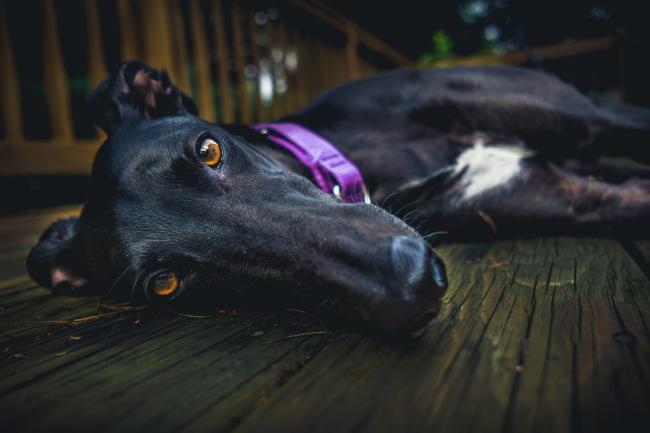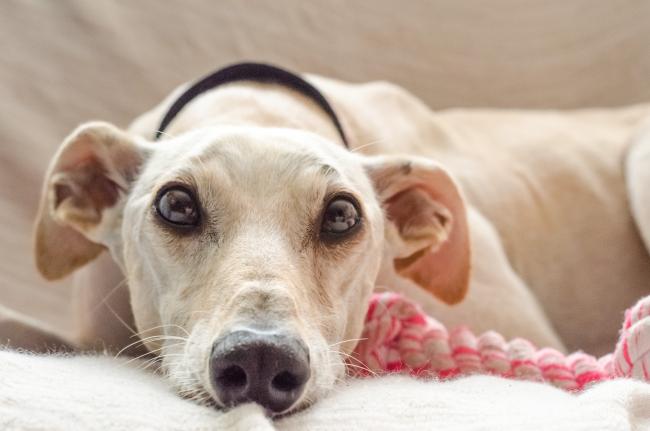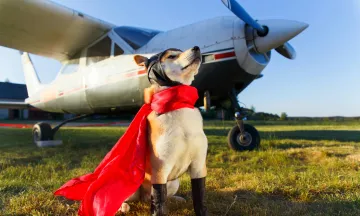Greyhound: Breed Information

Fact sheet
- Breed name: Greyhound
- Classification: Hound / Sight Hound
- Size: large
- Coat: short and smooth
- Colour: Grey, white, black, tan, red, blue, brindle or combinations of these colours.
- Personality: shy, loyal
- Family-friendly: yes, though best for families with older children
- Friendly with other pets: no, due to their strong prey drive
Greyhound Background
The Greyhound is an ancient dog breed originating in the deserts of North Africa. Images of greyhounds found in mosaics and stone carvings show that the breed looks much the same now as it did then.
Greyhounds arrived in Europe in the early Middle Ages and were favoured by royalty. Throughout history, Greyhounds have usually been kept as hunting dogs for birds and small prey.
One of the most iconic associations many people have with Greyhounds is of the racing industry. Greyhound racing began in the USA in the late 19th Century and still takes place in some locations. However, many people see greyhound racing as a cruel sport, and the industry is facing tighter regulations and bans around the world.
Physical Appearance of the Greyhound
Greyhounds are natural sprinters and have always been bred to be fast. As such, they have long bodies, long legs and muscular shoulders that are perfect for running at speeds of up to 64 km an hour. Furthermore, their sleek fur, small ears and pointed snout and tail are perfectly shaped to cut through the air. They can have very little body fat, though are capable of putting on weight if over-fed.
Greyhounds come in many different colours, but their fur is always short and sleek. They can weigh anywhere between 25 kg - 40 kg and stand up to 75 cm tall.
Greyhound Behaviour and Temperament
Greyhounds have often been misunderstood due to their racing reputation. In fact, they can make excellent family pets due to their placid and trusting nature. Furthermore, they have relatively low stamina and are happiest when cuddling on the couch. However, your Greyhound will still need at least one good walk (or run!) a day.
Greyhounds can be a little shy around strangers and need to be well socialized, which can present a challenge if your dog is adopted from a shelter. As such, be patient with your Greyhound and give them plenty of opportunities to have positive meetings with new people.
Many dog experts recommend keeping Greyhounds muzzled when out and about. The reason for this is that they have a strong ‘prey drive’ and will chase after smaller animals. Therefore, always keep your Greyhound on a leash as they will be impossible to catch if they bolt.

Training and Exercising Greyhounds
Greyhounds need daily exercise but do best with a burst of activity than a long-distance run. As such, a 30-minute walk in the morning and evening should do the trick.
Training a Greyhound takes confidence and patience as they can be easily distracted by prey. Reward-based training is a good way to teach your Greyhound commands, as they can be sensitive to harsh words.
Living with a Greyhound
Although Greyhounds can get along with larger dogs, they pose a safety risk around smaller pets. Despite this streak, they are big softies around their human family and don’t like being left alone all day. Doing so can lead to separation anxiety.
These dogs are generally very low maintenance and adaptable at living in smaller homes, as long as they have daily exercise. It’s also essential to escape-proof your yard, as Greyhounds are excellent at jumping!
Lastly, it’s worth investing in a coat for your Greyhound as they can feel the chill during the winter months.

Greyhound Health
Greyhounds have the benefit of thousands of years of breeding and are generally very healthy dogs. However, their distinct physique means there are a few health issues to look out for:
- Hip Dysplasia
- Hyperthyroidism
- Hip Dysplasia
- Gastric Torsion or ‘Bloat’)
- Osteosarcoma
- Dental issues
Grooming
Greyhounds do shed fur, however, this is easy to deal with by giving them a regular brush with a soft brush head. Aside from that, they only need an occasional bath or wipe down. And be sure to give the outside of their ears a gentle wipe with a damp cloth to prevent infection.
As they have such short fur, Greyhounds can accidentally scratch or injure themselves. Therefore, have your Greyhound’s claws trimmed at the grooming salon every few months.
Lastly, Greyhounds can experience dental problems. As such, keep their teeth clean using dental chews and doggy toothpaste.
Does your Greyhound need someone to care for them while you are away? We can help! Find an experienced pet sitter on Pawshake today.





